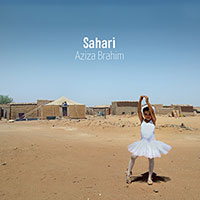Aziza Brahim - Sahari
 De boodschap van het nieuwe album van Aziza Brahim zit al vervat in de intrigerende hoesfoto van Sahari. Een jong meisje poseert in een hagelwitte tutu, maar niet voor de normale geprivilegieerde achtergrond die je wellicht zou verwachten, maar op een stoffige ondergrond voor een rij tenten en lemen huisjes in een vluchtelingenkamp. Geen vrolijke scene dus, maar toch straalt de foto optimisme en hoop op een beter toekomst uit, en met haar muziek wil Brahim dan ook vooral het verdriet van haar volk, en de miljoenen ontheemden in de wereld, een stem geven en hen ook een sprankel hoop geven: "My purpose is to denounce the extreme living conditions there and the great injustice that prevents Saharawi refugees from returning to their home. I try to capture the feeling of longing that my elders express for the land that was taken away and for their past life in their country. But I know it's not just us; there are currently 70 million people forcibly displaced in the world. 26 million of them are refugees. The normalisation of injustice is something that the Saharawis know well. By addressing that in the songs, Iím trying to fight against the prejudices some people have. We all see tragic news caused by the policies of reactionary governments. Of course thatís influenced the writing of the songs on this new album. How could it not?". Een van de sterkste nummers in die context is waarschijnlijk Ard El Hub geschreven door Sahrawi poŽet Zaim Alal: "My homeland the land of love, the cradle of my childhood, to you the longings rise, that embrace the skyÖ".
De boodschap van het nieuwe album van Aziza Brahim zit al vervat in de intrigerende hoesfoto van Sahari. Een jong meisje poseert in een hagelwitte tutu, maar niet voor de normale geprivilegieerde achtergrond die je wellicht zou verwachten, maar op een stoffige ondergrond voor een rij tenten en lemen huisjes in een vluchtelingenkamp. Geen vrolijke scene dus, maar toch straalt de foto optimisme en hoop op een beter toekomst uit, en met haar muziek wil Brahim dan ook vooral het verdriet van haar volk, en de miljoenen ontheemden in de wereld, een stem geven en hen ook een sprankel hoop geven: "My purpose is to denounce the extreme living conditions there and the great injustice that prevents Saharawi refugees from returning to their home. I try to capture the feeling of longing that my elders express for the land that was taken away and for their past life in their country. But I know it's not just us; there are currently 70 million people forcibly displaced in the world. 26 million of them are refugees. The normalisation of injustice is something that the Saharawis know well. By addressing that in the songs, Iím trying to fight against the prejudices some people have. We all see tragic news caused by the policies of reactionary governments. Of course thatís influenced the writing of the songs on this new album. How could it not?". Een van de sterkste nummers in die context is waarschijnlijk Ard El Hub geschreven door Sahrawi poŽet Zaim Alal: "My homeland the land of love, the cradle of my childhood, to you the longings rise, that embrace the skyÖ".
Voor dit album sloeg Aziza de handen ineen met Amparo Sanchez, die zich bezig hield met de pre-productie en vooral computereffecten en toets-accenten aan de muziek van Brahim toevoegde: "Amparo is an artist I've always admired. She suggested introducing electronics, and that meant recording in a different way. Before, we'd record everything live. This time we all worked in different studios then put the pieces together.". Het resulteerde in een album dat wellicht iets beter geschikt is voor een westers pallet dan Brahim's vorige albums: "For Sahari, I wanted to find that balance between the past and the present, between African and European music and to reach as many people as possible.". Dat is vooral te horen in tracks als Hada Jil of titelnummer Sahari, waarin naast Aziza's traditionele tabal-percussie ook elektronische beats te horen zijn. In Las Huellas ("de voetsporen") gaat Aziza zelfs de reggaetoer op en levert ook Amparo Sanchez een vocale bijdrage. Aziza Brahim blijft op Sahari tegelijk haar rebelse zelf, maar het album klinkt dankzij de bijdragen van Amparo Sanchez wellicht net iets toegankelijker dan haar voorgaande releases.
www.azizabrahim.com | www.glitterbeat.com | www.xmd.nl